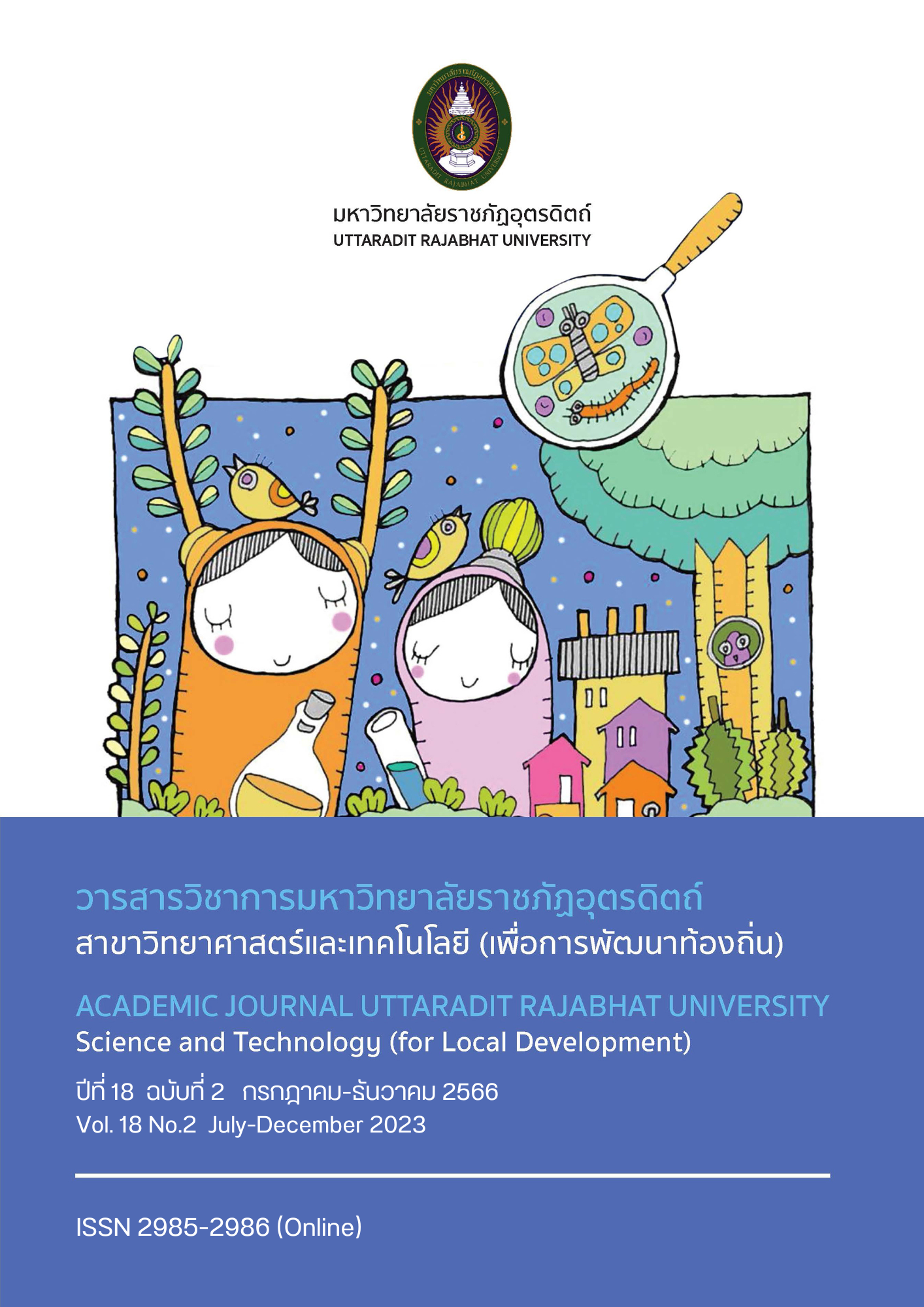การพัฒนาดินลมหอบผสมซีเมนต์สำหรับการก่อสร้างผนังดินอัด กรณีศึกษา ดินพื้นที่จังหวัดขอนแก่น
Main Article Content
บทคัดย่อ
งานวิจัยครั้งนี้มีวัตถุประสงค์เพื่อพัฒนาดินลมหอบผสมซีเมนต์สำหรับนำไปใช้ในการก่อสร้างบ้านดินด้วยเทคนิคการบดอัด และศึกษาคุณสมบัติทางวิศวกรรมของผนังดินอัด โดยปรับปรุงคุณสมบัติด้วยการผสมซีเมนต์และดินลมหอบขอนแก่น ที่อัตราส่วน 1:6 บดอัดโดยวิธีมาตรฐาน ด้วยปริมาณความชื้นที่เหมาะสมเท่ากับ 9.40 % ทดสอบการดูดกลืนน้ำโดยใช้ตัวอย่างขนาด 7.5 x 7.5 x 7.5 เซนติเมตร และทดสอบกำลังรับแรงอัดโดยการจำลองเป็นแบบผนังขนาดเล็ก ตัวอย่างขนาด 0.60 x 0.60 เมตร ที่ความหนา 7.5, 10, 12.5 และ 15 เซนติเมตร และระยะเวลาในการบ่ม 7, 14 และ 28 วันตามลำดับ จากผลการวิจัยพบว่าการก่อสร้างผนังดินอัดเมื่อทำการบดอัดชั้นแรกด้วยความสูง 60 เซนติเมตรแล้วเสร็จ จะต้องปล่อยให้ผนังดินอัดใช้ระยะเวลาในการแข็งตัวเป็นระยะเวลา 24 ชั่วโมง จึงจะเริ่มดำเนินการบดอัดชั้นต่อไปได้ หลังจากนั้นทำการบ่มผนังดินอัดไว้ 14 วัน ก่อนการใช้งานเพื่อทำให้ผนังดินอัดได้พัฒนากำลังรับแรงอัด โดยมีกำลังอัดเทียบเท่าผนังอิฐก่อทั่วไป สำหรับคุณสมบัติทางด้านวิศวกรรมผนังดินอัดมีค่าการดูดกลืนน้ำที่แช่ในน้ำ 24 ชั่วโมง เท่ากับ 10.56% ความหนาของผนังดินอัดที่เหมาะสมมีความหนาเท่ากับ 12.5 เซนติเมตร เนื่องจากค่ากำลังรับแรงอัดที่ระยะเวลาการบ่ม 14 วัน เท่ากับ 45.16 กิโลกรัมต่อตารางเซนติเมตร มีอัตราส่วนความชะลูดที่สูงที่สุดที่มีกำลังรับแรงอัดผ่านค่ากำลังรับแรงอัดของปริซึมอิฐก่อชนิดต่าง ๆ ในกรณีผนังก่อแบบไม่รับแรง ผลการวิจัยนี้มีประโยชน์ต่อประชาชนทั่วไปที่ต้องการนำดินในพื้นที่มาสร้างผนังดินอัดผสมซีเมนต์ รวมถึงการประยุกต์ทำอิฐดินอัดผสมซีเมนต์เพื่อเป็นการสร้างรายได้ให้กับชุมชน
Downloads
Article Details

อนุญาตภายใต้เงื่อนไข Creative Commons Attribution-NonCommercial-NoDerivatives 4.0 International License.
เอกสารอ้างอิง
ชินะวัฒน์ มุกตพันธุ์. (2561). ปฐพีกลศาสตร์. (พิมพ์ครั้งที่ 5). มหาวิทยาลัยขอนแก่น.
ชูศักดิ์ คีรีรัตน์ และสุธน รุ่งเรือง. (2562). การพัฒนาก้อนอิฐดินดิบผสมใบกล้วยและขุยมะพร้าวเพื่อเป็นวัสดุก่อสร้างสำหรับบ้านดิน. วารสารวิศวกรรมศาสตร์ มหาวิทยาลัยเทคโนโลยีราชมงคลล้านนา, 4(1), 8-15.
วิหาร ดีปัญญา และกิตติพงษ์ สุวีไร. (2560). การพัฒนาผนังบ้านดินสำเร็จรูปที่ต้านทานการชะล้างสูงและเป็นฉนวนป้องกันความร้อนที่ดีสาหรับอาคารอนุรักษ์พลังงานและสิ่งแวดล้อม (รายงานการวิจัย). มหาวิทยาลัยเทคโนโลยีราชมงคลพระนคร. https://repository.rmutp.ac.th/xmlui/bitstream/handle/123456789/3152/ENG_62_03.pdf?sequence=1&isAllowed=y
สำเนียง องสุพันธ์กุล, วราธร แก้วแสง และสาโรจน์ ดำรงศีล. (2559). พฤติกรรมทางกลของผนังดินซีเมนต์บดอัดภายใต้แรงกดอัดสำหรับบ้านดิน. การประชุมวิชาการระดับชาติ มหาวิทยาลัยเทคโนโลยีราชมงคลรัตนโกสินทร์ ครั้งที่ 1: เรื่อง นวัตกรรมอาคาร 2559 (น. 11-20). มหาวิทยาลัยเทคโนโลยีราชมงคลรัตนโกสินทร์.
อธิปัตย์ อภิชาโรจนศักดิ์. (2561). การพัฒนาอิฐบล็อกประสานชนิดรับน้ำหนักโดยใช้ดินลมหอบผสมกับแกลบ [วิทยานิพนธ์ไม่มีการตีพิมพ์]. มหาวิทยาลัยราชภัฎมหาสารคาม.
อนุชาติ ลี้อนันต์ศักดิ์ศิริ. (2565). การศึกษากำลังรับแรงผนังอิฐก่อภายใต้การทดสอบด้วยเพนดูลัมเทส. การประชุมวิชาการและนำเสนอผลงานวิจัยระดับชาติครั้งที่ 9 และระดับนานาชาติ ครั้งที่ 7 มหาวิทยาลัยภาคตะวันออกเฉียงเหนือ (น. 503-514). มหาวิทยาลัยภาคตะวันออกเฉียงเหนือ.
American Society for Testing and Materials. (2000). ASTM D4318: Standard test method for liquid limit plastic limit and plasticity index of soil. ASTM International. https://kashanu.ac.ir/Files/D%204318%20-%2000%20%20_RDQZMTG_.pdf
American Society for Testing and Materials. (2002). ASTM D422: Standard test method for particle-size analysis of soils. ASTM International. https://www.epa.gov/sites/default/files/2020-01/documents/sedc_2004-2005_append.pdf
American Society for Testing and Materials. (2014). ASTM D854:Standard test methods for specific gravity of soil solids by water pycnometer. ASTM International. https://tajhizkala.ir/doc/ASTM/D854-14.pdf
American Society for Testing and Materials. (2018). ASTM C39:Standard test method for compressive strength of cylindrical concrete specimens. Ed Webster. https://www.scribd.com/document/426461320/ASTM-C39-Compressive-Strength-of-Cylindrical-Concrete-Specimens-pdf
American Society for Testing and Materials. (2018). ASTM D4221: Standard test method for dispersive characteristics of clay soil by double hydrometer. ASTM International. https://webstore.ansi.org/standards/astm/astmd422118
American Society for Testing and Materials. (2021). ASTM D698: Standard test methods for laboratory compaction characteristics of soil using standard effort. ASTM International. https://www.astm.org/d0698-12r21.html
Arun, L., Sarangapani, G., & Prasanna, H. S. (2021). Characteristics of high strength stone masonry using cement-soil mortar. Turkish Journal of Computer and Mathematics Education, 12(10), 3826-3841.
Balaguer, L., Vegas López-Manzanares, F., Mileto, C., & García-Soriano, L. (2019). Assessment of the thermal behaviour of rammed earth walls in the summer period. Sustainability, 11(7), 1924. https://doi.org/10.3390/su11071924
Bui, Q. B., Morel, J. C., Reddy, B. V., & Ghayad, W. (2009). Durability of rammed earth walls exposed to 20 years to natural weathering. Building and Environment, 44(5), 912-919. https://doi.org/10.1016/j.buildenv.2008.07.001
Davidson, D. T., Pitre, G. L., Mateos, M., & George, K. P. (1962). Moisture - density, Moisture – strength and compaction characteristic of cement – treated soil mixture, 41st Annual Meeting of the Highway Research Board (pp. 42-63). Highway Research Board.
Draper, N. R. & Smith, DH. (1996). Applied Regression Analysis. (3rd Ed.). Wiley Series in Probability and Statistics (pp. 707-713). John Wiley & Sons, Ltd.
Jose, A. & Kasthurba, A. (2021). Stabilization of lateritic soil for masonry applications. Magazine of Civil Engineering, 101(1), 10109. https://doi.org/10.34910/MCE.101.9
Maniatidis, V. & Walker, P. (2008). Structural capacity of rammed earth in compression. Journal of Materials in Civil Engineering, 20(3), 230-238. https://doi.org/10.1061/(ASCE)0899-1561(2008)20:3(230)
Morel, J. C. & Pkla, A. (2002). A model to measure compressive strength of compressed earth blocks with the 3 points bending test. Construction and Building Materials, 16, 303-310. https://doi.org/10.1016/S0950-0618(02)00023-5
Pacheco-Torgal, F. & Jalali, S. (2012). Earth construction: Lessons from the past for future eco-efficient construction. Construction and Building Materials, 29, 512–519. https://doi.org/10.1016/j.conbuildmat.2011.10.054
Terrel, R. L., Epps, J. A., Barenberg, E. J., Michell, J. K., & Thomson, M. R. (1979). Soil stabilization in pavement structures. A user's manual, volume 2. mixture design considerations. Washington : Government Printing Office.
Vyncke, J., Kupers, L., & Denies, N. (2018). Earth as Building Material – an overview of RILEM activities and recent Innovations in Geotechnics. MATEC Web of Conferences, 149(4). https://doi.org/10.1051/matecconf/201814902001


